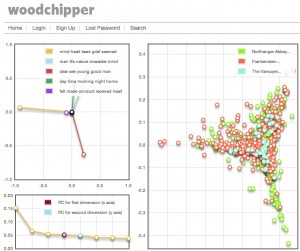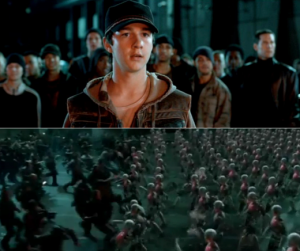To study how the Gothic novel might have changed over time, I divided our set of texts into four chronologically based periods.
Late 1700s: The Mysteries of Udolpho, The Monk, Caleb Williams
Early 1800s: Northanger Abbey, Frankenstein, The Vampyre
Mid 1800s: Varney the Vampyre, Wuthering Heights, Jane Eyre
Late 1800s: The Beetle, The Time Machine, Dracula, The Picture of Dorian Grey, Dr. Jekyll and Mr. Hyde, The Mystery of Edwin Drood, Carmilla
(Due to availability of texts, the last group used more than twice as many as the first. I did some test runs with a subset of the late 1800′s to see how much the large/small group would affect my results and it did not seem significant for the purposes of my analysis. I would have liked to increase size of all four groups, but I didn’t have the texts to do it.)
Splash Patterns
When I divided the gothic novels into sub-periods, I was hoping that woodchipper would find some interesting changes in the splash patterns. Based on some of Moretti’s ideas about a new genre starting out a bit shaky, then stabilizing, then branching out, I expected more variation in the earliest and latest sets than in the middle sets. I had hoped the woodchipper would prove that the early period was when the gothic was still figuring itself out (the splash patterns would be indistinct, fewer strong lines, less overlap between novels), that the middle periods were where it coalesced (strong lines, lots of overlap), and during the later period, I hoped the woodchipper would find evidence of the different subgenres diverging (strong lines, but going in different directions).
I could find some evidence to support my theory, but it was weak, and maybe I was looking too hard for it. The earliest patterns were somewhat fuzzy, but not remarkably so. The lines did get a little stronger and the overlap increased between the late 1700s and the early 1800s, but it wasn’t particularly dramatic. Then the middle 1800s definitely had the most overlapping patterns, but their lines were not noticeably sharper. I found an instance or two of nice diverging lines in the late 1800s, but also some splash patterns that were just as well aligned as earlier periods.
The following are the runs that most fit my hypothesis. Other runs don’t fit as well.
Early 1700′s: Not much definition.

Early 1800′s: Getting a little bit sharper.

Middle 1800′s: Maybe sharper yet?

Late 1800′s: Clear divergences

So I tried a more generalized chronological run, with larger groups—pre 1850 and post 1850. I didn’t think the pictures would be very good with so many novels occupying the same space at once, but I was pleasantly surprised. I could see pretty clearly that the early set overlaps much better, but has weaker lines, than the later set, which has much sharper lines and stronger divergences.
The samples I’ve chosen this time are quite typical of the set. The only problem is the splash pattern is much more difficult to see, as the titles overlap it.
Before 1850: Pretty fuzzy, but overlapping well

After 1850: Sharper but more divergent

So my larger groupings seem to illustrate the way the Gothic genre may have started out fuzzy, but then crystalized, just in time to diverge, as Moretti suggests genres behave in “Trees.” However, woodchipper was not able, in my runs, to separate the crystallization step from the diverging step.
Topics
I was also interested in the topics that the woodchipper found and had some luck finding patterns with my four chronologically based sub-periods of the Gothic novel. First, the most consistent topic, which appears at about the same rate in all periods is the one I’m calling “Good Conduct.” Some other trends emerge across time. For instance, I found a handful of topics that start out strong but fade through time. “Crime” is extremely prevalent in late 1700s, but then disappears after that. “Grief,” “Nature” and “Character” are very prevalent in both the late 1700s and early 1800s, but disappear as topics in the mid and late 1800s. “Hope,” “Escape,” and “Goodness” are all most common in the earliest parts of the period, fade slowly, and are completely gone by the time of the late 1800’s.
Other topics move in the opposite direction, to become stronger over time. “Doubt” occurs throughout the period, but is not all that prevalent in the late 1700s, early and middle 1800s. It swells remarkable in the late 1800s. Both “Faces” and “Aristocracy” rise to prominence in middle and late 1800s, but are not seen before then. “Knowledge” first appears (just once) in mid-1800’s, but then becomes very prevalent in late 1800s. “House Interior” belongs with this group, gaining momentum in later years. It occurs once in the late 1700s, disappears in the early 1800s, but become extremely strong in the middle and late 1800s.
“Time” is the only topic in which I can see a marked ebb and flow. It first appears in the early 1800s, stays prevalent in the middle 1800’s and sticks around, but is less prevalent in the late 1800s.
The topic of “Existence” is very prevalent in the early 1800’s and occurs only there. I am sure, however, that this is due to one novel’s obsession with the topic (Frankenstein). My samples aren’t large enough to stop one novel from throwing the results and so I’m skeptical of other one-period topics, such as “Hearing,” and “Sky”(only middle 1800s), “House exteriors,” “Mind,” and “Sleep” (only late 1800s).
So then, what can I make of the way certain topics build over time and others fade? The topics that start strong then fade are “Crime,” “Nature,” “Character,” “Hope,” “Escape,” and “Goodness.” The topics that build up later in the period are “Doubt,” “Faces,” “Aristocracy,” “Knowledge,” and “House Interior.”
An easy observation is the way “Hope” gives way to “Doubt” as the two can be seen as opposites. Perhaps in some ways the gothic becomes less optimistic through the years.
These results also suggest to me that the early Gothic was more concerned with the extremes of human behavior. Think of the powerful extremes of “Nature.” Then think about the way a person’s “character” might move between “Crime” and “Goodness.” In contrast, the later topics appear more ambiguous to me. Maybe the later novelists are making more nuanced arguments. There may be a longing for certainty or “Knowledge,” but “Doubt” suggests there no real way to get it. Then I think about the way you might use “Faces” and “House Interiors” to find or impart knowledge—it would be an interpretive act. It makes me think of a less imperious, more sophisticated search for truth—perhaps even understanding it as less certain and more interpretive.
This idea appeals to me–that of gothic novels moving, over time, from certain judgment of good and evil toward a more nuanced and complicated approach to knowledge and understanding. The woodchipper has not proved this movement, of course. But it suggests a direction for further study.










